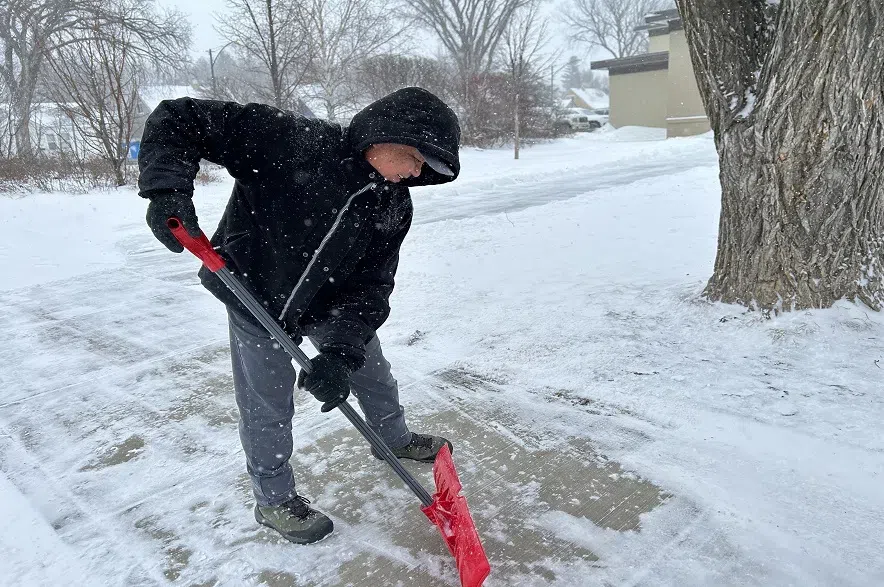The snow is here in Saskatchewan, and if you haven’t got any yet, it might be coming your way on Friday.
Environment Canada forecaster Brad Vrolijk said if you are headed to the West Division Final at Mosaic Stadium in Regina on Saturday, you might have to the brush snow off your seat.
Read more:
- Saskatoon police urge drivers to use caution after responding to 22 minor crashes
- City of Saskatoon crews are getting ready for anticipated snowfall
- Governing Saskatchewan Party looks to rebuild in cities ahead of weekend convention
“Unless maybe you’re hiking out in Maple Creek or something like that, you’re probably going to see some snow by tomorrow,” he said.
Vrolijk said the weather at kickoff on Saturday is expected to be around -6 C or -7 C, with cloudy skies and winds in the 15-20 km/h range.
“Saturday is going to be one of the cooler days we’ve actually seen so far this year,” he said.
“If you’re heading out to the game, you’ll want to bundle up a little bit, because it’s going to feel cool out there.”
By the time the Riders are in the fourth quarter, Vrolijk said temperatures will dip to around -10 C, with the wind dying down a bit.
“If you bundle up, have hot chocolate or something, probably not too bad,” he said.
Ten centimetres of snow fell in parts of Sask. on Thursday
Vrolijk said much of west central and southeastern Saskatchewan saw snowfall on Thursday, with amounts ranging between two and 10 centimetres.
“It’s certainly time for winter to start arriving, I think. For many areas, there is going to be some more snow today for the region,” the forecaster said.
Vrolijk said areas around Saskatoon, North Battleford, Outlook, Kindersley and Leader got between two and four centimetres of snow on Thursday.
The Meadow Lake and Prince Albert areas were hit the hardest, with between five and 10 centimetres of snow falling.
“Once you get south of the Trans Canada Highway corridor, it was quite a bit warmer yesterday, more on the rain shower side,” Vrolijk explained.
“Some areas got a dusting of snow overnight, especially a bit further west, but that’s kind of the general layout for this whole system.”
More snow on the way on Friday
Vrolijk said the snow on Thursday blew into the province thanks to an Alberta clipper system. He said another clipper is forming on Friday, but this one is forminer in southern Alberta rather than central Alberta.
“We’re having almost a repeat of yesterday, just further south,” he said.
He said some snow or rain will move into the Leader and Kindersley regions on Friday morning, and will continue moving southeast through the day.
“We’ll see a swath of snow move from the Leader and Kindersley region down towards Moose Jaw, with some rain showers south of that for areas like Swift Current and maybe the Shaunavon and Maple Creek areas,” said Vrolijk.
“Then, through the afternoon hours, that will continue to slump southeast towards Estevan and into North Dakota.”
Areas along the entire stretch from Kindersley down to Estevan could see between four and eight centimetres of snow on Friday, the forecaster noted.
“It’ll really depend exactly how much rain mixes in, exactly how warm it gets. It can be very tricky in these shoulder seasons and these mixed precipitation events to know exactly how much you get,” Vrolijk said.
Saskatoon might see flurries on Friday to follow up the blast of snow that hit the city on Thursday, but Vrolijk said not much snow will accumulate on the ground.
Snow is expected in Regina on Friday, with Vrolijk expecting between two and four centimetres.
“Nothing huge, but definitely a dusting. Enough to probably say ‘Hey, winter is here. You might want to drive a little differently,’” said Vrolijk.
“Temperatures will be getting colder after this, so ice on roads may become an issue in the next day or two. But fortunately, after this system it looks like a much longer stretch of dry weather, so everything should dry out.”
CAA shares winter driving tips
The Canadian Automobile Association (CAA) and Prairieland Ambulance Care have released a checklist to help drivers get ready for the upcoming winter season.
CAA advised drivers to check weather and road conditions before travelling, and allow more time to safely get where you need to go.
“Be prepared to reduce your speed and drive with caution,” CAA said in a statement.
Make sure to clear ice and snow from your vehicle and make sure your headlights and taillights are on, the organization noted, and remember to use signal lights well in advance.
CAA also advised drivers to be ready to slow down to 60 km/h on highways for first responders, tow truck operators, law enforcement, paramedics, firefighters and highway construction workers, as well as snowplow operators at work.
The organization also suggested motorists have a roadside safety kit packed, including extra winter gear like mitts, toques and footwear for all passengers.
“Take along a mobile phone with charger, non-perishable food, water, a shovel, a window ice scraper, a snow brush, and booster cables,” said CAA. “If you become stranded, ensure your vehicle is parked safely, and stay in your vehicle for temporary shelter until help arrives.”
Be prepared with a plan to contact help if needed, the organization said.
CAA also recommended using winter tires, as they allow for better traction and control, and said driver should consider the tread design, type of rubber, size and conditions when buying winter tires.
Tire pressures should be checked regularly to ensure they are correct for traction and fuel efficiency, CAA noted.
“Improper inflation can not only be dangerous but can also cause increased tire wear, resulting in added costs for replacement tires. Review your vehicle’s owner’s manual,” said CAA.
Batteries should also be checked, CAA added, to ensure they are charged and in optimum condition.
The motor safety association said drivers should make sure their block heater and cord are in good, working condition, and said block heaters should be used whenever temperatures fall below -15 C.
CAA recommended keeping gas tanks full or at least half full, which helps prevent water from getting in and reduces the risk of running out of fuel on a cold day.
The organization said during extreme cold weather, vehicles may need to be started a few times throughout the day, running for six to seven minutes to warm up the engine.
Parkland Ambulance Care offers winter safety advice
Parkland Ambulance Care in Prince Albert also shared some tips on how to stay safe while driving in winter conditions.
“If you become stuck or stranded, stay with your vehicle, signal for help, keep your exhaust pipe free of ice and snow, use your engine only for a short while just to warm up the vehicle,” the ambulance service said in a statement.
Parkland advised people to dress appropriately for the weather by wearing layers and always wearing gloves or mitts and a hat.
If hands or feet become frozen, Parkland said to warm them quickly, watch for blisters, and look for medical help, as hypothermia can set in quickly.
“Get immediate medical help for anyone you suspect has a cold injury,” the organization advised.
–with files from 980 CJME’s Florence Hwang











